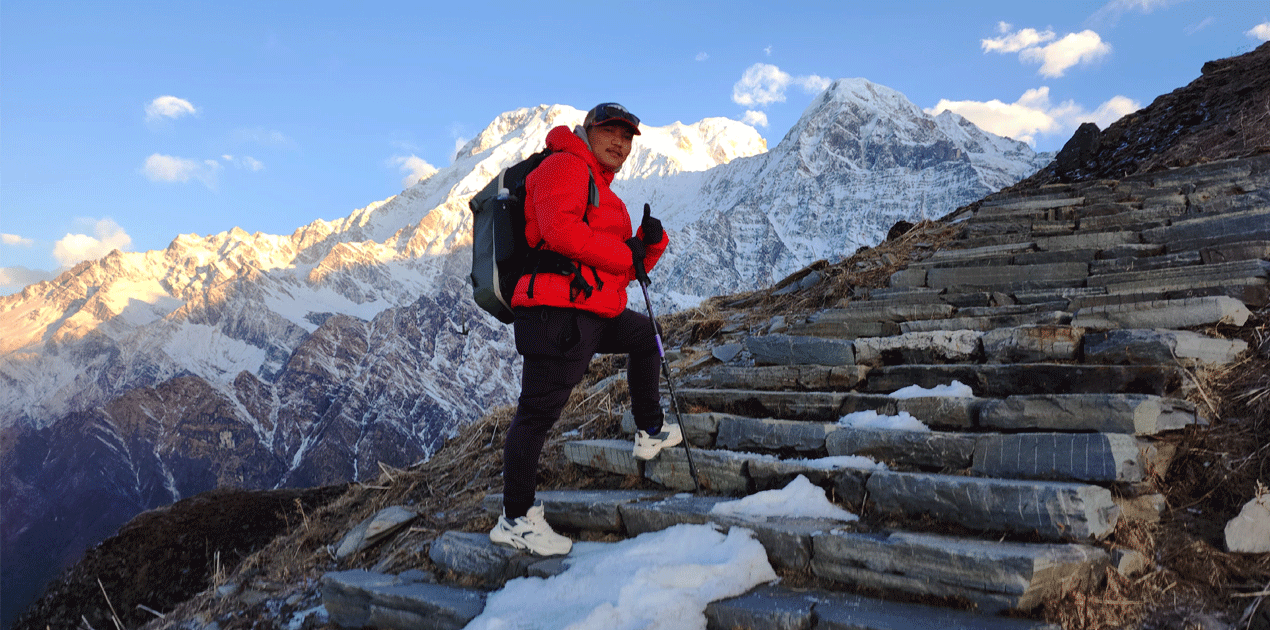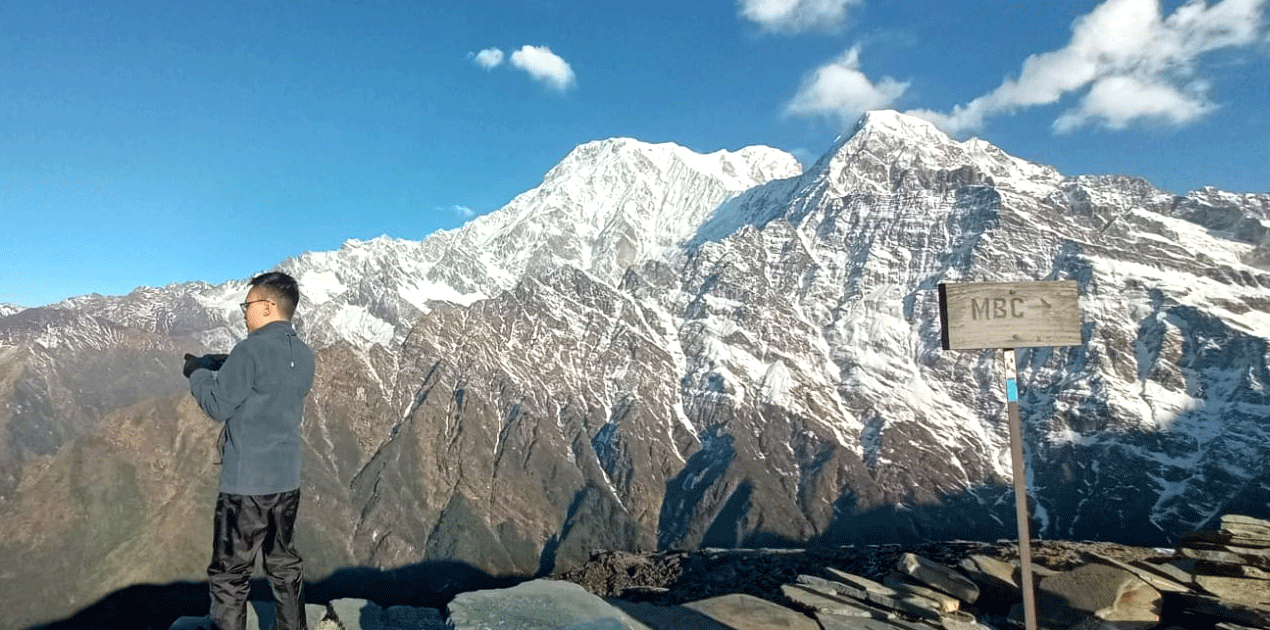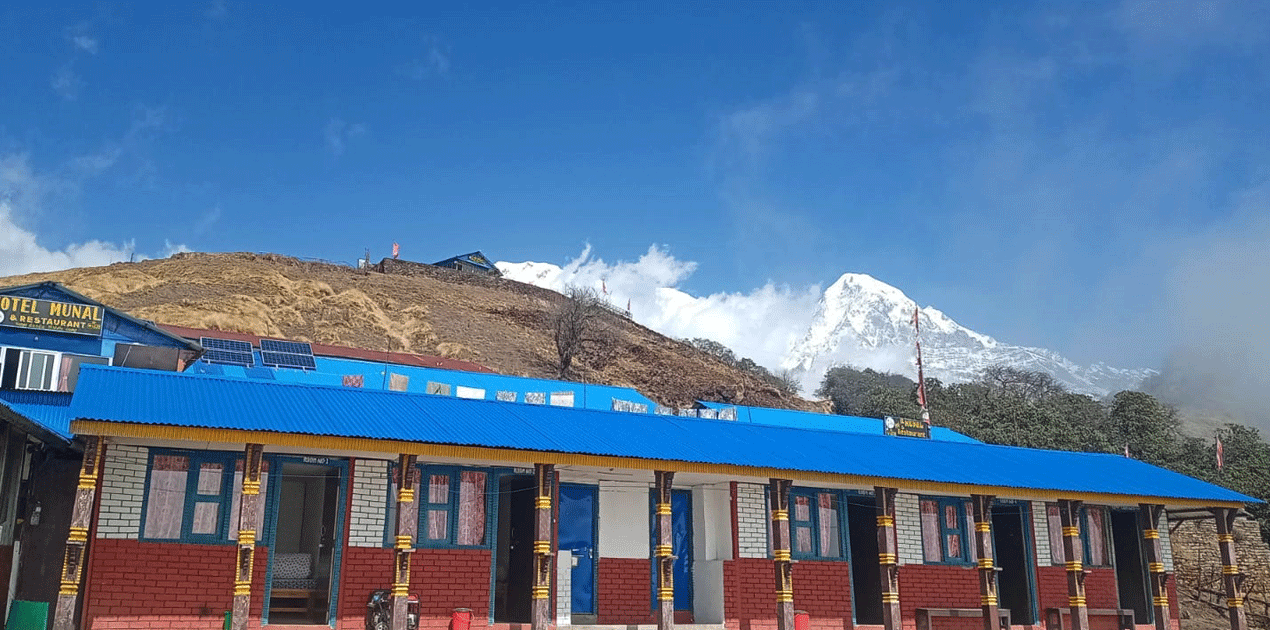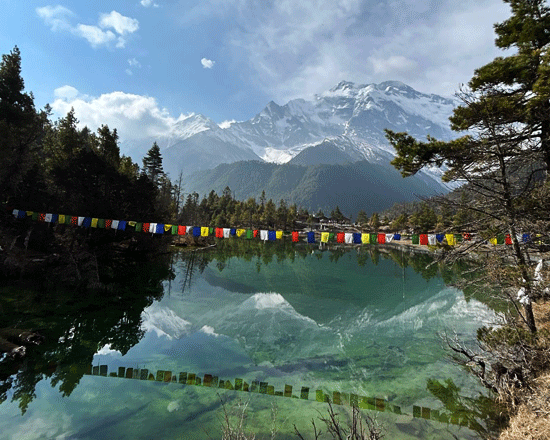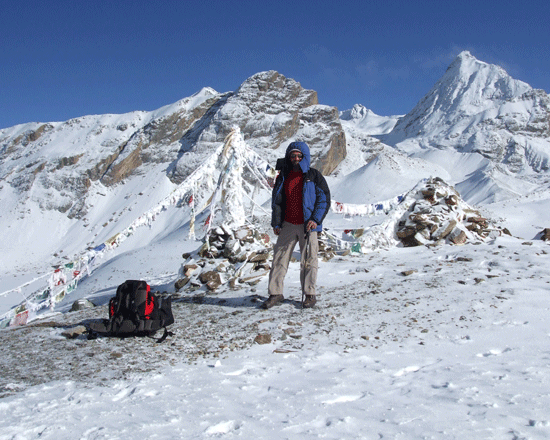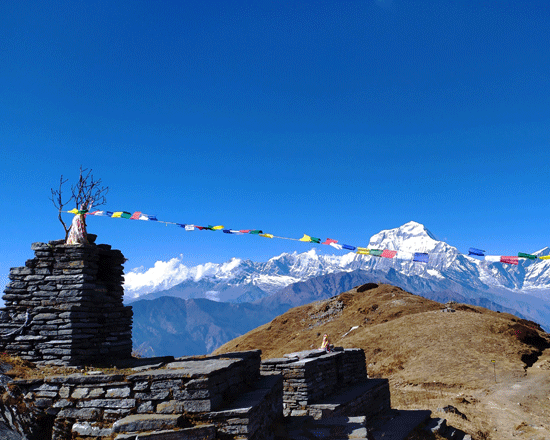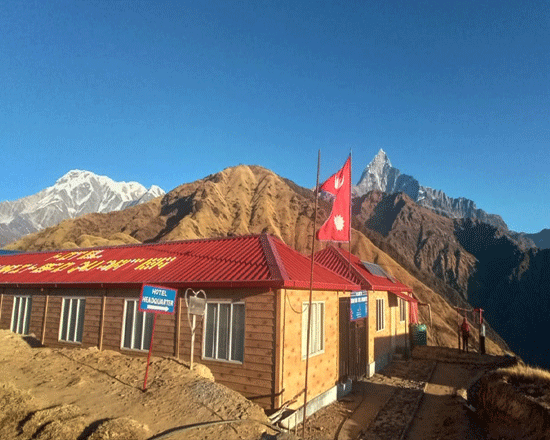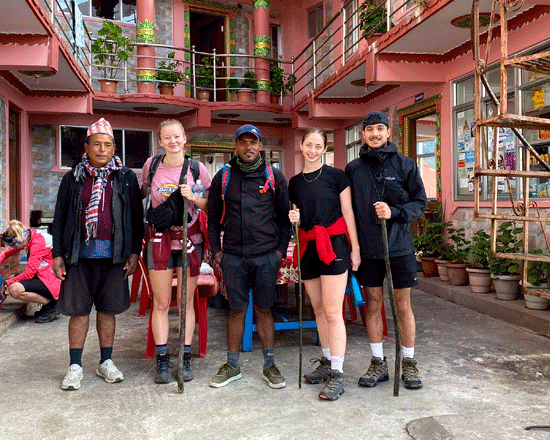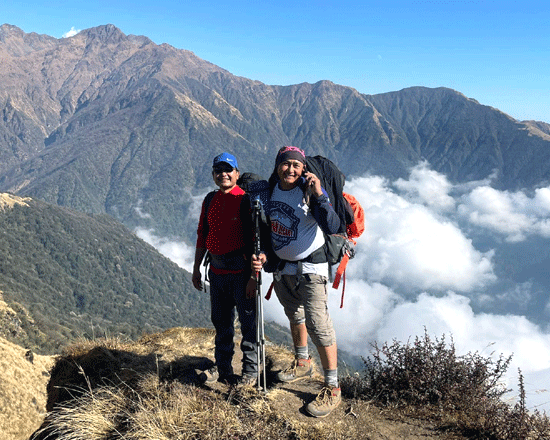3 Days Mardi Himal Trek
3 Days Mardi Himal Trek
Annapurna RegionTrip Facts
Since the terrain can be hard and the days long, hikers on these treks should be in good physical condition and have some previous mountain walking experience. Steep climbing may be involved, although it is never necessary to use ropes. Treks at this level can he arranged for periods of 16 to 21 days. Typically, a gradual ascent through a green river valley will lead you up to a number of high passes, where you will reach the altitude of 5416m. Often times, you will get a close insight into the Tibetan culture. Participants should expect to trek above 5416m/17872ft.
100%
Overview
Three Days Mardi Himal Trek, A Short But Memorable Adventure
3 Days Mardi Himal Trek is a hidden gem in Nepal’s Annapurna. This is a short but stunning trekking trail which takes enthusiasts into enchanted forests, peaceful ridges, and then to high-altitude vantage points with stupendous scenery of mountains. Ideal for short but spirited trekkers, this trek packs stunning landscapes, cultural richness, and an essence of adventure all within a matter of a few days.
While one of the shortest treks in Nepal, the Mardi Himal trekking route offers breathtaking mountain scenery rivaling the more popular and longer treks. Towering peaks like Machapuchare (Fishtail), Annapurna South, Hiunchuli, and Mardi Himal itself, towering above the clouds, this trek is as grandiose as any expedition.
A Trek Off the Beaten Path
Unlike more touristy, heavily used trails such as the Annapurna Base Camp or the Everest Base Camp treks, the Mardi Himal trail is relatively less touristy. It winds its way through untouched forests, rural villages, and peaceful alpine meadows, providing one with an impression of seclusion and tranquility.
Trekkers are taken aback by the sparseness of humanity they encounter, especially during the early mornings or late afternoons. The solitude ensures the trek is ideal for people looking for a more intimate encounter with nature and the mountains. The trail still is unbroken in spirit, with pristine landscapes and occasional wildlife interactions like Himalayan monals, langurs, or even barking deer.
Unmatched Mountain Views
The central focus of the Mardi Himal Trek is unquestionably the stunning mountain landscape. There are few such short treks in the world to offer as much exposure to dramatic, snow-covered peaks. Throughout the trip, there are hair-raising views of the Annapurna massif, especially Machapuchare, dominating the skyline with its signature fishtail shape.
On dewy dawns and sunsets of gold, the entire mountain range glows with golden lights, and dream-like landscapes are ideal for photography, meditation, or simple wonder-struck contemplation. At the Mardi Himal Viewpoint, towering above the clouds, one experiences as if at the edge of the world.
Coming Closer to Nature
One of the most magical aspects of the 3-day Mardi trek is the fantastic variety of natural terrain seen in such a short distance. Beginning in thick subtropical forests of rhododendron, ferns, and moss, the trail leads gradually up into alpine landscapes where the vegetation gets less and less, and the ground becomes rocky and rough.
In spring, the forest is filled with hues since rhododendron flowers of red, pink, and white hues bloom, while autumn arrives with crisp air, blue sky, and picturesque scenery. There are also excellent bird-watching chances on the trail, and Himalayan bulbul, woodpeckers, and Nepal’s national bird Danphe, flutter in the forest.
Along the way up, however, the terrain opens out as one crosses broad open ridges and great swooping valleys. That transition between forests and the high meadows at alpine height treats walkers to the total Nepal experience ecologically.
Local Hospitality and Cultural Encounters
While the Mardi Himal Trek is renowned for its natural beauty, it also offers an insight into the way of life of the Gurung and Magar inhabitants of this region. Their stone houses, rice terraces, and warm hospitality give travelers an insight into the cultural diversity of the Himalayas.
Along the way, friendly locals welcome trekkers into family-run tea houses, where home-cooked breakfasts and hot drinks are served beside cozy wood-burning stoves. Conversations with inn owners and other travelers create friendships that will likely last long past the end of the trek.
Most of the villagers on this trek have close connections to mountain living, with relatives serving as porters or guides in the Annapurna or Everest districts. Their histories enrich and make more human the experience of trekking.
A Trekking Experience for All
3 days Mardi Himal Trek’s brevity and comparative moderate grade render it accessible for a broad variety of trekkers. It is a great option for:
• First-time trekkers wanting a taste of Himalayan adventure
• Photographers seeking panoramic vistas without multi-week commitments
• Couples or solo travelers looking for a quiet nature escape
• Fitness-conscious adventurers who prefer active travel
Despite its short length, the trek reaches high elevations, making it both rewarding and slightly challenging. With proper pacing and a good level of physical fitness, most people can complete the trek comfortably.
Seasonal Beauty – A Year-Round Option
The Mardi Himal Trek 3 days is beautiful all year round, and every season offers its beauty.
- Season of Spring (March to May): Perhaps the most perfect time, with pleasant weather and rhododendron forests in bloom. The weather is generally clear, and the trails are dry and accessible.
- Autumn (September to November): Excellent time, with settled weather, clear skies, and crisp mountain air. It is also a peak trekking season, so tea houses are filled with other tourists.
- Winter (December to February): While cold, winter is a special, peaceful experience. Snow may cover the higher trails, but the view of snow-capped peaks is breathtakingly dramatic.
- Monsoon (June to August): Not suggested due to rain, slippery paths, and limited visibility. However, the forests are at their greenest, and the crowds have gone away.
Eco-Friendly and Sustainable Trekking
The 3-day Mardi Himal trek, being less established than other normal treks, is an excellent example of sustainable trekking tourism. Your trip directly supports the local economy as most tea houses on the trekking route are family businesses, and no plastic water bottles are available en route.
Visitors are also asked to follow Leave No Trace principles, pack out their trash, minimize single-use plastics, and use local resources. Some trekkers also use water purification equipment to avoid plastic bottles.
Guides and tour operators are also joining conservation organizations to help keep the trail clean and sustainable, so the Mardi Himal’s beauty can be enjoyed for generations to come.
Food, Comfort, and Connectivity
Despite being remote, the Mardi Himal trail has tea houses offering plain, satisfying, wholesome food. The trekkers can enjoy traditional Nepali cuisine like dal bhat, accompanied by pancakes, fried rice, noodles, soups, and snacks.
Basic rooms in most tea houses include twin beds, thick blankets, and shared toilet and bathroom facilities. While not very luxurious, they are clean, warm, and cozy, perfect for a good night’s rest after a day of hiking.
Electricity is generally available (generally solar), and some lodges offer mobile charging at a nominal fee. Wi-Fi is available at some tea houses, but switching off and being one with nature is advised. Local SIMs generally work up to High Camp, depending on weather and companions.
Trekking with or without a Guide
The majority of trekkers choose to trek the Mardi Himal Trek with a guide, not just for safety purposes, but also to better understand the culture, history, and environment of the region. A guide can also help with logistics, reservations at tea houses, and emergency planning.
All that aside, this trek is also possible to do without a guide for those who are experienced hikers. The path is well-marked, though having a GPS-capable map application or offline maps is recommended for solo trekkers.
Hiring a porter is also an option, and you can hike with a small daypack. Porters are usually locals, and their services provide a valuable source of income to rural families.
Ideal Companion to Your Nepal Journey
If you are visiting Pokhara or spending more time in Nepal, the Mardi Himal Trek is the ideal companion to your journey. It offers a true taste of Himalayan grandeur and beauty without taking weeks to plan and trek. For visitors to Annapurna Base Camp, Poon Hill, or longer treks, Mardi Himal 5 days can be incorporated as a warm-up or an acclimatization trek. Alternatively, for visitors who want a complete trekking experience within less than four days, this is an ideal choice.
Final Thoughts
The 3-Day Mardi Himal Trek proves that it’s not necessary to take weeks to experience the magnificence of the Himalayas. In a short span, you’ll trek through lush forests, ascend sensational ridges, and gaze at some of the most iconic mountains on earth.
3-day trek is the perfect blend of nature’s majesty, human hospitality, physical challenge, and spiritual calm. An experienced trekker or an aspiring traveler exploring the mountains for the first time, Mardi Himal invites you to step in and discover all this and more. Approach with an inquiring mind, and leave behind memories that will remain with you eternally.
For those planning a trek from Pokhara, it’s helpful to know the Pokhara to Mardi Himal distance, which makes this journey both accessible and rewarding within a few days. If you’re looking to combine scenic beauty with cultural richness, the Classic Mardi Himal – Poon Hill Trek is an excellent choice. Still deciding between routes? Compare the highlights of Mardi Himal vs Annapurna Base Camp to choose what suits you best. And if you’re in Kathmandu with limited time, the Shivapuri day hike offers a perfect nature escape close to the city.
Detail Itinerary
- Day 1: Drive from Pokhara to Kande (1,770m) – Trek to Forest Camp (2,540m)
- Pick-up time: 7:00 AM from your hotel in Pokhara
- Drive: 1.5 hours / 40 km via scenic countryside road to Kande
- Trek duration: 5–6 hours
- Distance: ~8–10 km
- Elevation gain: +770m
- Trek Overview:
After a scenic drive past terraced farmlands and traditional Gurung villages, you’ll begin your hike from Kande. The trail initially ascends to Australian Camp (2,050m), offering panoramic views of Annapurna South, Hiunchuli, and Machhapuchhre (Fishtail). You’ll pass through Pothana (1,950m), where ACAP permits are checked. - From here, the trail enters the lush rhododendron and oak forest, a haven for birdlife such as the Himalayan Monal (Nepal’s national bird), woodpeckers, and langurs. After a few more hours through peaceful woodland trails, you reach Forest Camp, also known locally as “Kokar.”
- Cultural Note: The region is home to the Gurung people, an ethnic group known for their bravery as Gurkha soldiers and their rich cultural heritage, including folk songs, dances, and Buddhist traditions.
- Day 2: Trek from Forest Camp (2,540m) to High Camp (3,580m)
- Trek duration: 5–6 hours
- Distance: ~7–8 km
- Elevation gain: +1,040m
- Trek Overview:
Today’s trail climbs steadily through dense forests of rhododendron, hemlock, and moss-covered trees, transitioning into more open terrain with dwarf vegetation and alpine shrubs. Along the way, Low Camp (2,970m) and Badal Danda (3,210m) provide great rest spots with mind-blowing views of Machhapuchhre (Fishtail), Annapurna South, and Mardi Himal. - As you reach High Camp (3,580m), the landscape opens up to alpine meadows, and the peaks appear closer than ever. Sunset from here is mesmerizing, painting the mountains in hues of gold and crimson.
- Flora & Fauna: You may spot Himalayan Thar, barking deer, pheasants, and eagles along this forest-to-alpine transition zone.
- Day 3: Hike to Mardi Himal Viewpoint (4,200m) – Trek to Siding Village (1,750m) – Drive to Pokhara
- Early morning hike: 2–3 hours to View Point (round trip: ~6 km)
- Descent to Siding: 5–6 hours / ~10 km
- Drive back to Pokhara: 2.5–3 hours / ~45 km
- Total hiking duration: ~7–8 hours
- Trek Overview:
Pre-dawn, start your sunrise hike to Mardi Himal Viewpoint (4,200m). The trail is steep but rewarding, with spectacular close-up views of Machhapuchhre (6,993m), Mardi Himal (5,587m), Annapurna I (8,091m), and Hiunchuli (6,441m). You’ll traverse high ridgelines with breathtaking drop-offs on both sides, above the cloud line. - After soaking in the panorama, return to High Camp for breakfast and begin your descent through rhododendron forests to Siding Village (a beautiful Gurung settlement).
- Cultural Note: Siding offers a glimpse into traditional rural life, where locals farm organically and practice Buddhism. You may see prayer flags, mani walls, and old-style stone homes.
- From Siding, a jeep will transfer you back to Pokhara in about 2.5–3 hours, driving through a mix of dirt tracks and paved roads, passing through small hillside villages and terraced farms.
- ✅ Quick Summary
| Day | Elevation (m) | Hiking Distance | Driving Time | Main Highlights |
|---|---|---|---|---|
| Day 1 | 1,770 → 2,540 | ~8–10 km | 1.5 hrs | Australian Camp, forests, Gurung culture |
| Day 2 | 2,540 → 3,580 | ~7–8 km | — | Rhododendron forests, High Camp views |
| Day 3 | 3,580 → 4,200 → 1,750 | ~16 km total | 2.5–3 hrs | Mardi viewpoint, Siding village, return to Pokhara |
Cost Included
- Pokhara to Kande by private car or Van and Sidding village to Pokhara by sharing a jeep on the way back.
- Clean Lodge accommodation on the way during your Mardi Himal Base Camp Trek.
- Italian, Chinese, Nepali, Indian, and many other European Delicious Meals three times a day (Breakfast, lunch, and dinner chosen from the Menu)
- ACAP permit and TIMS card permit for the Mardi Himal trek
- Experienced English-speaking trekking guide licensed by the government, familiar with the area.
- One porter for every two to three participants. (Note: An additional cost applies for solo clients requiring a porter.)
- Guides/Porter's food, accommodations, bus transportation, salary, insurance, equipment, etc.
- A kitbag for storing your belongings for the trek, carried by the porter
- Sleeping bag for a comfortable night's sleep on a trek in minus-25 degrees
- Necessary paperwork, all government, and local taxes
- A certificate of appreciation from Nepal Wilderness Trekking after a successful trek
Cost Excluded
- Airfare for international flights
- Upon arrival at Tribhuwan International Airport, Nepal entry visa fees vary by duration (15 days - $25-30, 30 days
- Accommodations and meals in Kathmandu and Pokhara before and after our journey
- Personal equipment for high and cold temperatures
- Emergency high-altitude rescue and evacuation are covered by travel insurance
- All beverages, Soft and caffeinated table drinks such as Coke, beer,
- Drinking water/mineral water, Dessert, etc. Hot shower, laundry
- Tip for the guide and the porter
- Excluded are all costs and expenses not listed under "cost includes."
- Inclusion of costs or delays beyond the control of the management, such as landslides, weather conditions, itinerary modifications due to safety concerns, illness, changes in government policies, strikes, etc.

